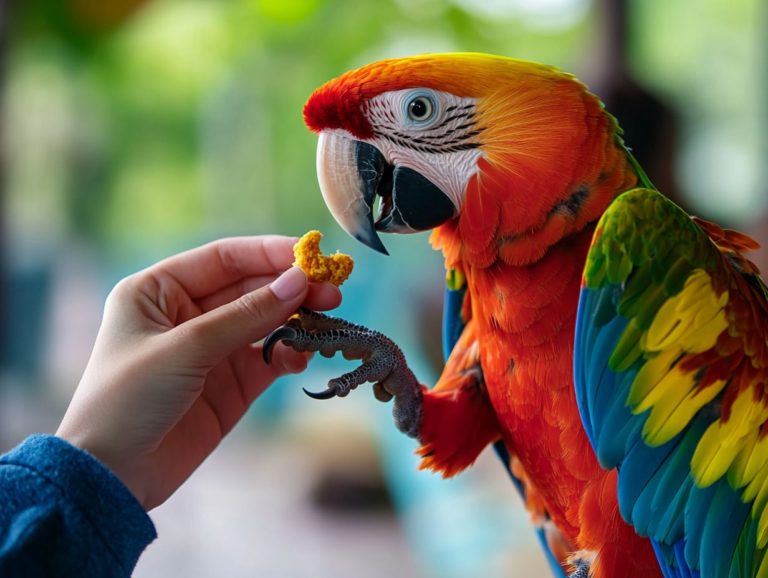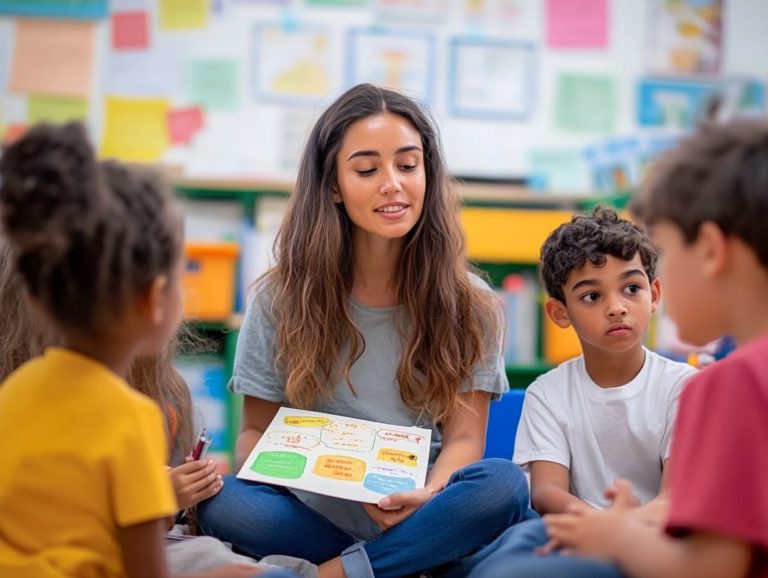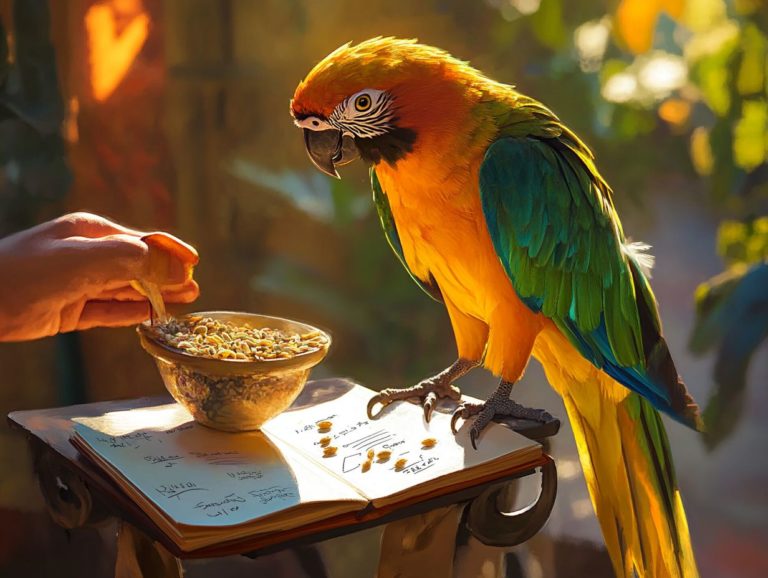5 Key Strategies for Training Multiple Birds
Training multiple birds, such as an Alexandrian parrot or a Camelot macaw, can be both delightful and challenging. With the right approach, you can nurture individual skills while fostering a harmonious environment among your feathered companions.
This article delves into five essential strategies to elevate your training sessions. From establishing routines to rewarding good behavior, we will explore the benefits and challenges of training multiple birds. You’ll learn the importance of understanding body language, discover safety tips, and find common techniques to promote bonding among your avian friends.
Get ready to transform your training adventures whether you’re teaching a parrot or a cockatoo!
Contents
- Key Takeaways:
- 1. Establish a Routine
- 2. Use Positive Reinforcement
- 3. Train Each Bird Separately
- 4. Incorporate Group Training Sessions
- 5. Stay Consistent and Patient for Best Results
- How to Prepare for Training Multiple Birds?
- Frequently Asked Questions
- What are the 5 key strategies for training multiple birds?
- How important is consistency when training multiple birds?
- Why is positive reinforcement the best approach when training multiple birds?
- Why is individualized training necessary when working with multiple birds?
- How does socialization play a role in training multiple birds?
- Why is patience important when training multiple birds?
Key Takeaways:
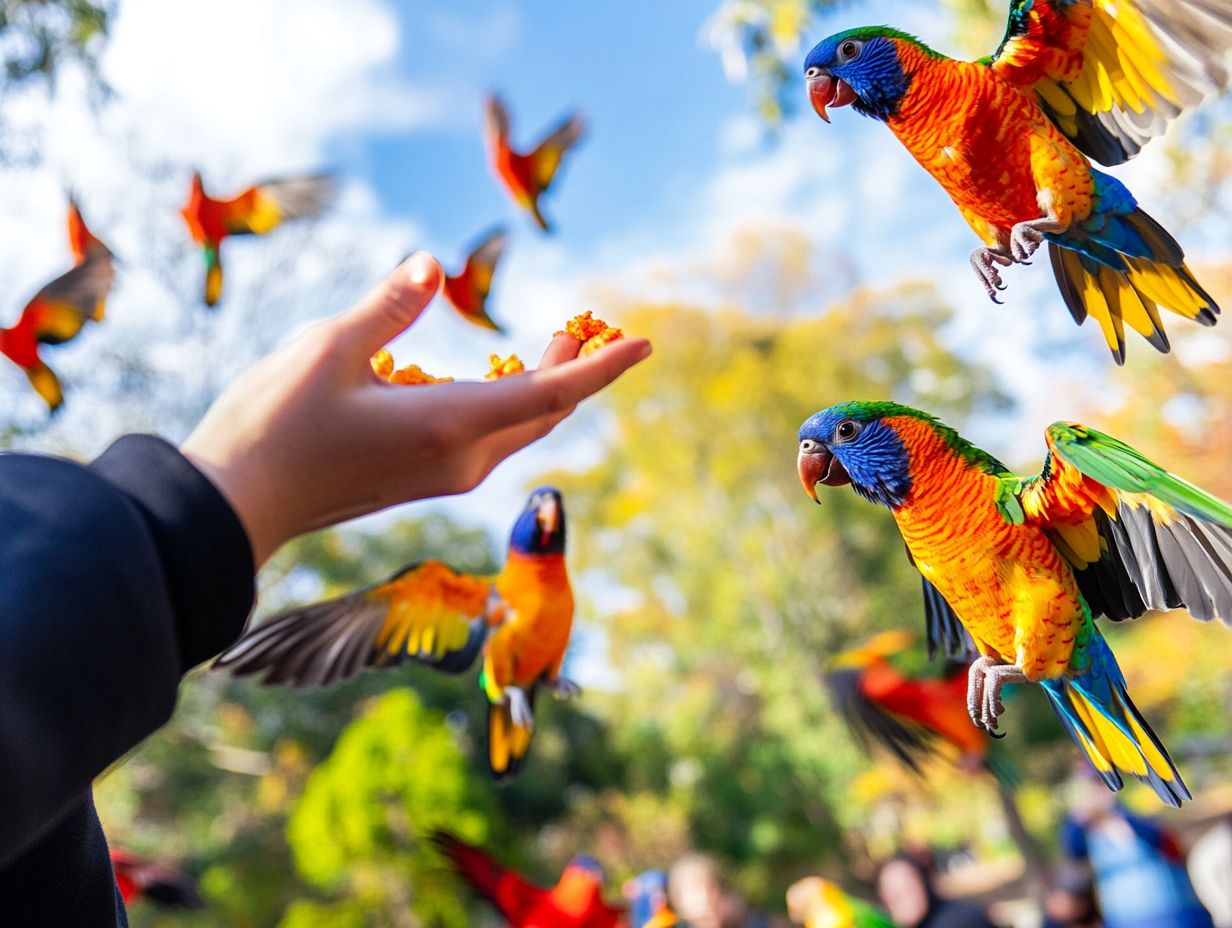
- Establish a consistent routine for training to keep the birds engaged and focused on learning.
- Reward good behavior with treats, praise, and clicker training to encourage desired actions from each bird.
- Train each bird separately to avoid competition and ensure individual attention and progress.
1. Establish a Routine
Establishing a training routine is crucial for effectively teaching your parrot commands, such as the “step up” and “step down” commands. This routine fosters a rich environment of understanding and interaction between you and your feathered companion.
Incorporating regular training sessions into your daily life ensures your parrot becomes adept with various learning methods, including rewarding good behavior, clicker training, and potty training. Consistency is essential as it reinforces desired behaviors and commands, leading to a well-behaved and happy bird.
To create a successful routine, set aside specific times each day for training while allowing for ample opportunities for play and social interaction. A balanced approach keeps your parrot engaged without feeling overwhelmed. Opt for short training sessions of 5-10 minutes, interspersed with breaks for playtime or exploration.
During these sessions, using rewards like treats or praise not only motivates your parrot but also strengthens your bond. Remember, training should feel like an enjoyable game rather than a tedious chore; this positive atmosphere will encourage your parrot to learn and flourish.
2. Use Positive Reinforcement
Positive reinforcement is the cornerstone of effective bird training. This approach encourages your parrot to repeat desired behaviors by linking them to rewards like treats or using a clicker for added engagement. It celebrates good behavior and deepens the understanding between you and your pet.
Techniques such as clicker training enhance this experience, enabling you to communicate effectively with your parrot while establishing a trusting relationship. By adopting this method, you can use a range of effective rewards tailored to your bird s preferences, whether it be small pieces of fruit, nut treats, or a beloved toy.
For instance, when your parrot successfully hops onto a perch on command, pairing that action with a click followed by a reward reinforces the connection between the command and the behavior. Over time, this encourages your bird to engage in the desired behavior more frequently.
This fun process strengthens the bond between you and your bird, transforming training sessions into moments both of you eagerly anticipate. Start today to see incredible results!
3. Train Each Bird Separately
When training multiple birds, such as a finch and a canary, focus on each one individually. This approach ensures they receive the attention they need and learn at their own pace, leading to a better understanding of commands and behaviors.
Training separately minimizes distractions that often occur in group sessions. This allows each bird to grasp the unique commands and techniques you’re teaching. Investing time in one-on-one interactions enhances their learning and strengthens the bond you share with each pet bird.
This customized method lets you adapt your training strategies to suit the distinct personalities of your birds whether they are timid, adventurous, or inquisitive, like a Galah or an African grey parrot.
To conduct effective training sessions:
- Create a serene environment devoid of noise and other birds.
- Begin with brief sessions lasting around 10 to 15 minutes to keep their attention.
- Gradually extend the duration as they become more at ease.
Incorporating positive reinforcement, like treats or praise, can motivate them and turn learning into a delightful experience. Remember, consistency is crucial; regular practice solidifies their learning and establishes a routine they can look forward to.
4. Incorporate Group Training Sessions
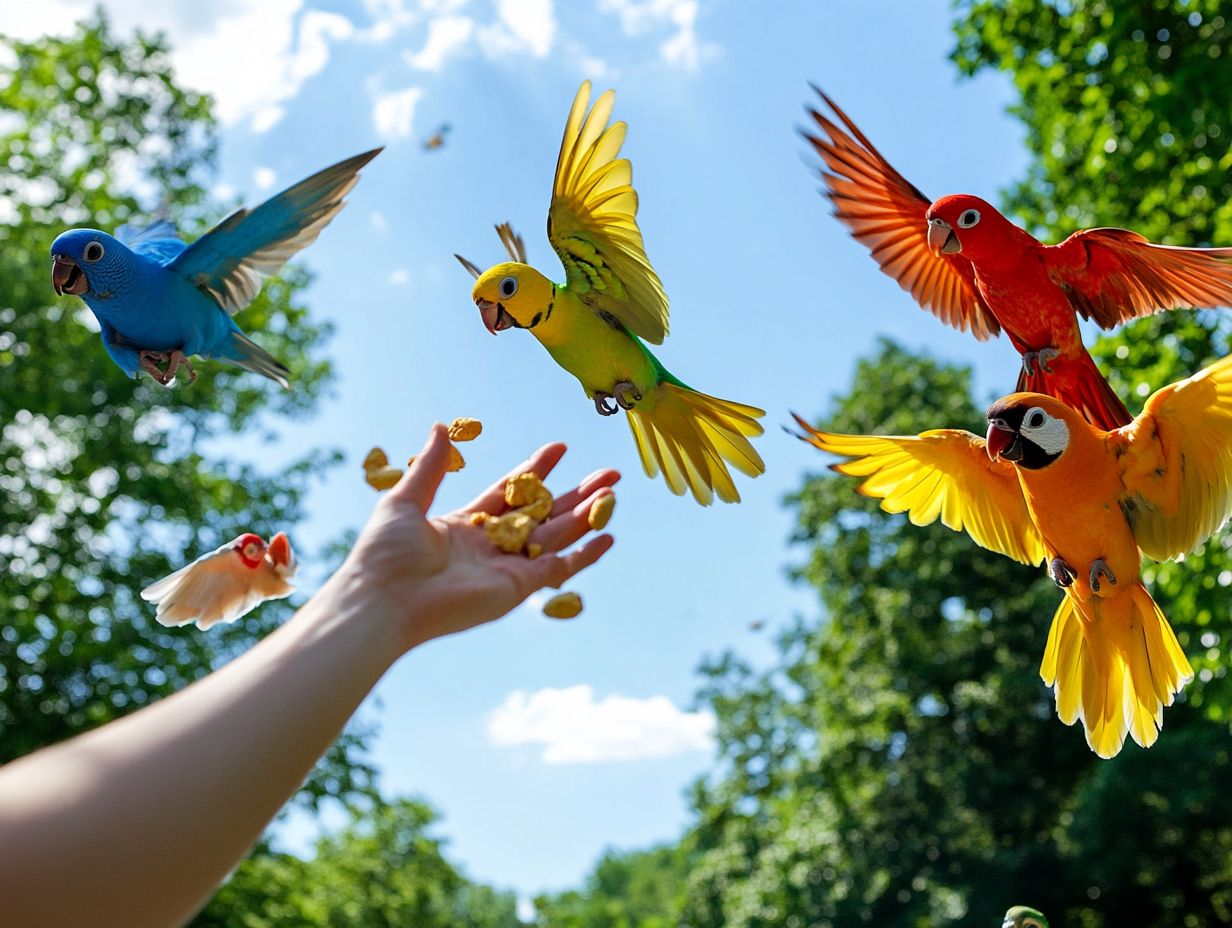
Group training sessions are an excellent strategy to enhance socialization among your parrots and pet birds while teaching them commands and behaviors. These lively sessions can spark healthy competition and camaraderie, allowing the birds to learn from each other and reinforce their understanding.
Facilitating interactions during training cultivates a supportive community among your parrots, vital for their emotional well-being. However, manage group dynamics thoughtfully to ensure that each parrot, whether a parakeet or an Amazon parrot, receives the attention they deserve.
Forming smaller sub-groups allows for focused engagement, preventing any bird from feeling overshadowed. Utilize various training techniques like turn-taking to ensure that each parrot participates actively, fostering a sense of equality among them.
Introduce a diverse array of training activities, like foraging games, to keep the sessions engaging. This approach caters to different learning styles and encourages the formation of social bonds through shared experiences.
A well-structured approach to group training can lead to improved social skills and a harmonious environment for your feathered companions.
5. Stay Consistent and Patient for Best Results
Consistency and patience are vital in your journey of successful bird training, as highlighted by B.F. Skinner’s study of how animals and people learn. These qualities help reinforce desired behaviors and commands over time, deepening the understanding between you and your parrot.
Maintain a regular training schedule and use the same cues and rewards to establish clear expectations. This makes the learning process smoother. Patience helps you handle challenges and ensures that each training session remains positive and encouraging.
To elevate your training experience, keep a training journal to track methods and progress. This tool helps you reflect on effective methods and pinpoint when adjustments are needed. Not only does this foster personal accountability, but it also reveals patterns in your bird’s behavior.
Recognize that learning takes time; both you and your feathered friend will benefit from a measured approach. Celebrate those small victories and keep training sessions enjoyable, nurturing a trusting bond where your bird feels secure and empowered to learn.
Start your training journey today, and watch how quickly your feathered friends learn!
How to Prepare for Training Multiple Birds?
Preparing to train multiple birds requires thoughtful planning and an understanding of their individual needs. This creates a helpful environment for learning. To enhance your training efforts, consider implementing techniques to improve bird recall. Ensure that each pet bird gets the attention and support it needs for effective training.
Establish a consistent routine to enhance the birds ability to anticipate training sessions. This includes readiness for potty training, or teaching birds where to go to the bathroom, and other tasks. Outline specific goals for each session, keeping in mind the unique characteristics and preferences of the birds. This approach fosters a respectful and engaging atmosphere.
When designing your training curriculum, break down complex skills into smaller, manageable steps. This allows each bird to progress at its own pace, making learning enjoyable. To enhance your training approach, consider incorporating the top 5 toys for training your bird. Schedule training sessions at times when the birds are most alert and eager to engage, as this greatly impacts training success.
What Are the Benefits of Training Multiple Birds at Once?
Training multiple birds simultaneously, whether a cockatiel or a Galah, offers many benefits. These include enhanced socialization, increased stimulation, and the chance for healthy competition among your feathered friends. This collective learning experience encourages interaction and camaraderie as the birds learn to respond to commands together, creating a lively training atmosphere.
In a group setting, your birds can mimic each other’s behaviors and commands. This significantly speeds up the learning process and enhances their understanding of cues.
As they interact, your birds naturally strengthen their social skills and fend off feelings of isolation. This dynamic not only deepens their bonds but also provides important mental enrichment as they navigate social interactions. You can observe these exchanges and adjust your training techniques to align with each bird s unique personality and learning style. Such an environment fosters a sense of community among the birds, making the entire training journey enjoyable.
Ultimately, this shared experience enriches both the birds and you as the trainer, leading to a harmonious atmosphere where everyone flourishes.
What Are the Challenges of Training Multiple Birds?
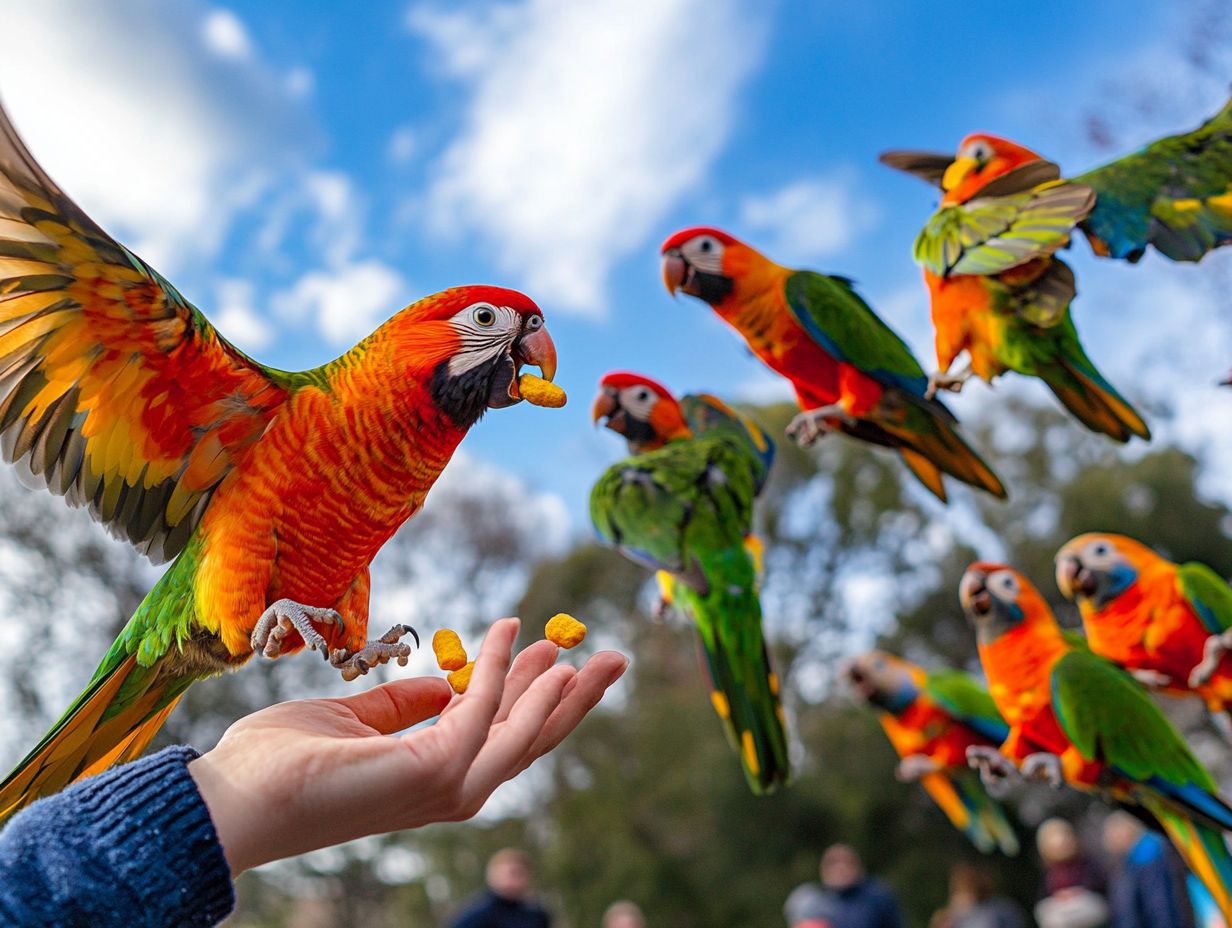
Training multiple birds is exciting but can also be challenging! You’ll need to manage distractions, different learning speeds, and ensure each bird receives the attention it deserves during sessions. These hurdles may confuse the birds and hinder progress, complicating the reinforcement of desired behaviors. Recognizing these obstacles is essential for crafting best practices for bird training sessions that foster a positive training experience for every bird involved.
Effective management starts with keen observation. By closely monitoring each bird, you can identify individual strengths and weaknesses, allowing you to tailor your approach to their unique learning styles.
Embrace adaptability in your training sessions to improve group dynamics. For instance, rotate activities to keep their interest alive and minimize distractions. Using shorter, focused sessions can help maintain order and boost engagement.
Celebrating small successes not only motivates the birds but also highlights the value of cooperation, cultivating a more harmonious training environment overall.
In conclusion, with thoughtful preparation and a supportive approach, training multiple birds can be a rewarding experience. Start your journey today and enjoy the wonderful bond you’ll create with your feathered friends! For more insights, check out the best training techniques for pet birds. Feel free to share your experiences or ask questions about bird training.
How Can You Ensure Safety During Training?
Ensuring safety during bird training is essential. Pay careful attention to the environment and the dynamics among the birds to prevent accidents and stress.
Create a secure training space that s free from hazards and distractions. This facilitates a positive training experience that encourages interaction while prioritizing the well-being of all your pet birds.
Be attentive to each bird s behavior. This will help you avoid any aggressive interactions during group sessions.
Remove potentially harmful items, like sharp objects or toxic plants. Ensure the area is well-lit and properly ventilated.
Keep a close eye on your birds for signs of distress. Pacing, fluffing up feathers, or refusing treats are red flags indicating they might feel stressed or uncomfortable.
Establish a routine to help your feathered friends feel secure. This allows for gradual introductions and training milestones that foster a trusting relationship.
By actively monitoring their behavior, you ll enhance their training experience and ensure their happiness and safety.
What Are Some Common Training Techniques for Multiple Birds?
Several effective training techniques can be utilized for multiple birds. Focusing on simple tricks to start training your bird can encourage interaction and behavioral reinforcement within the group.
Employ structured group sessions to enable the birds to observe one another, enriching their learning experience.
Incorporate simultaneous commands to foster teamwork and cooperation. When one bird successfully performs a trick or responds to a cue, the others can learn by watching, promoting peer modeling.
Vary the environment with exciting props or toys to keep their interest piqued. This helps avoid the monotony that might arise from repetitive commands.
This dynamic group setting supports cognitive development and strengthens social bonds, transforming training into an enjoyable and rewarding experience for everyone involved.
How Can You Encourage Bonding and Cooperation Among the Birds?
Encouraging bonding and cooperation among your birds is vital for fostering a harmonious environment and enhancing their training experience.
Promote socialization and understanding each other to set the stage for joyful interactions. Create opportunities for positive connections, such as group training sessions and shared activities, to nurture strong relationships between your pet birds.
Reward cooperative behavior with treats and praise. This reinforces these bonds and encourages teamwork during training.
Incorporate interactive games that require teamwork, like puzzle-solving or scavenger hunts. This adds a playful element while promoting communication and trust.
Observe the dynamics between your birds during these activities to gain valuable insights into their personalities and social structures.
Implement structured group training techniques where they learn new commands together to deepen their connections.
Keep the atmosphere full of patience and encouragement. This approach reinforces the positive experiences they share, leading to a more cohesive flock that thrives on collaboration.
Frequently Asked Questions
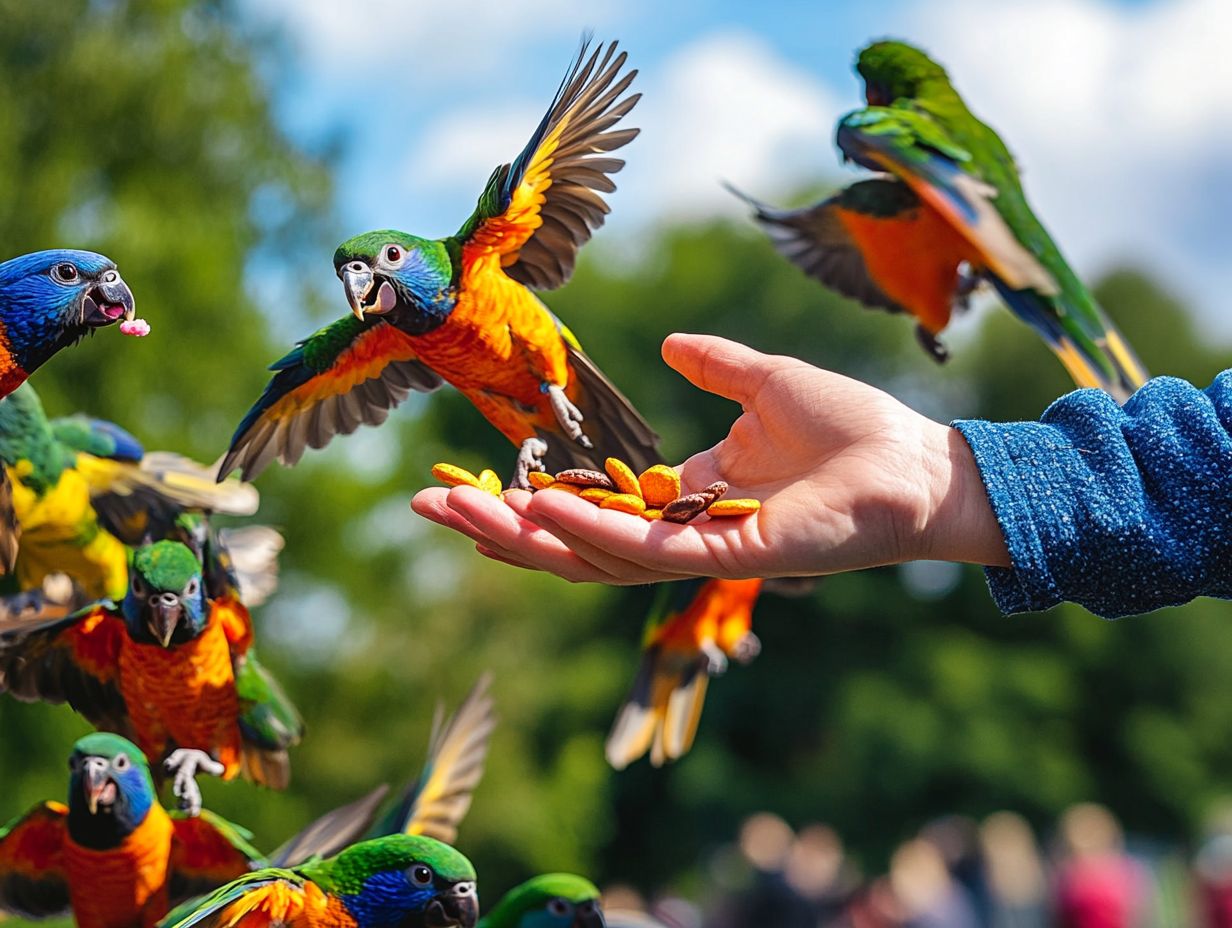
What are the 5 key strategies for training multiple birds?
The 5 tips for training older birds include consistency, positive reinforcement, individualized training, socialization, and patience.
How important is consistency when training multiple birds?
Consistency is crucial when training multiple birds, as it helps establish a routine and reinforces desired behaviors. To make the process enjoyable, check out how to keep training fun for your bird.
Why is positive reinforcement the best approach when training multiple birds?
Positive reinforcement, like using treats or praise, encourages birds to repeat desired behaviors and builds a trusting relationship with their trainer.
Why is individualized training necessary when working with multiple birds?
Each bird has a unique personality and learning style, so it’s important to tailor the training approach to fit each bird’s needs.
Start training today and watch your feathered friends thrive!
Socialization with other birds and humans is vital for their well-being. It also helps them learn appropriate behaviors.
Why is patience important when training multiple birds?
Training multiple birds can be challenging. Each bird may learn at its own pace, so patience is key. Developing a structured approach by creating a training schedule for your bird can also help streamline the process.

